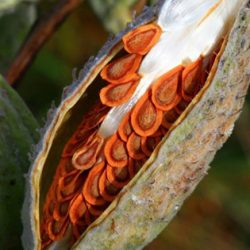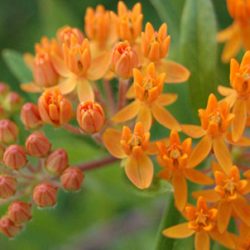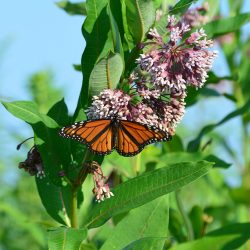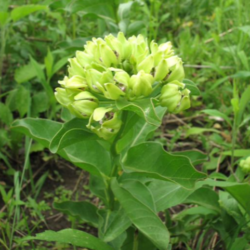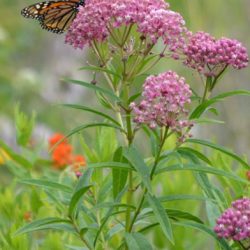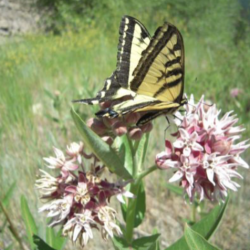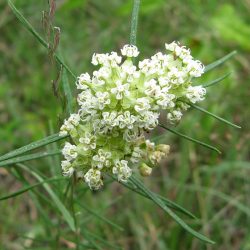MILKWEEDS
Monarch butterflies will only lay their eggs on milkweed, as that is the only food source for monarch caterpillars. Without milkweed, there would be no monarchs! The more milkweed we plant, the better their chances for survival. It has been a great pleasure for me to plant more milkweeds, as well as native nectar plants for the butterflies, and see a marked increase in monarch activity on our block. This is an easy and pleasurable way to make a difference!
Butterfly Weed (Asclepias tuberosa)
Showy orange flowers are a nectar source for butterflies, and the leaves are a food source for monarch and queen caterpillars. Grows well in dry to medium, well-drained soils in full sun. Seed pods split open in fall, dispersing handfuls of silky-tailed seeds. Summer blooming. Space 12-24”, grows 1-3’ tall, medium to dry soil, full sun.
Rose Milkweed aka Swamp Milkweed (Asclepias incarnata)
Grows best in moist soil but will tolerate average soils, and blooms for about a month mid-summer. Flowers are followed by large pods which break open to reveal seeds that float away in the wind. Fragrant flowers. Full sun.
Common Milkweed (Asclepias syriaca)
An easy, quick-growing milkweed. The large flowers can vary in color from nearly white to deep purple, with a delicate fragrance. Many native pollinators will benefit during its long bloom time! Can spread aggressively.
Whorled Milkweed (Asclepias verticillata)
Native to much of eastern and central US, this drought tolerant milkweed has a single stem with narrow leaves and white flowers. Prefers dry soils. Full sun, part shade.
Showy Milkweed (Asclepias speciosa)
Native to the western US and Canada, Showy Milkweed is found in prairies, meadows, roadsides, and other open spaces. Its thick, soft leaves are favored by monarch caterpillars. Showy Milkweed is also attractive to queens and many other butterflies, as well as hummingbirds and honeybees. Less invasive than Common Milkweed. Pink flowers. 3’ height, full sun.
Hairy Balls (Gomphocarpus physocarpus or Asclepias physocarpa)
Plants develop large, lime green, papery seed pods that earn its nickname. Although not a native milkweed, this variety is very popular with monarch caterpillars. A striking addition to the landscape, plants can reach 4’ in height, with gracefully arched branches. Seed pods are a beautiful addition in flower arrangements. Full sun, annual, sometimes self-seeds, open pollinated.
Tropical Milkweed (Asclepias currasavica)
I prefer planting native milkweeds, but for those of you who are raising monarch caterpillars and need a fast-growing food supply of milkweed, this one will do the trick. In addition to feeding monarch & queen caterpillars, tropical milkweed is an excellent nectar source for butterflies & hummingbirds. Full to partial sun, 3-5’ height, annual, sometimes self-seeds.
Antelope Horn Milkweed (Asclepias asperula) (coming later in May)
Native to the southcentral and southeastern United States, this milkweed is common in pastures, pastures and ditches, and other areas with little vegetative competition. Generally avoided by cattle and horses. A short milkweed (12-18”) with beautiful green flowers. Dry to medium soil, full sun.
Spider Milkweed (Asclepias asperula) (coming later in May)
- You cannot add "Milkweed, Showy" to the cart because the product is out of stock.

